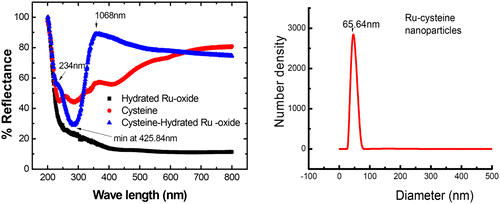Our official English website, www.x-mol.net, welcomes your
feedback! (Note: you will need to create a separate account there.)
l-Cysteine-Conjugated Ruthenium Hydrous Oxide Nanomaterials with Anticancer Active Application
Langmuir ( IF 3.7 ) Pub Date : 2018-01-11 00:00:00 , DOI: 10.1021/acs.langmuir.7b01408 Bichitra Nandi Ganguly 1 , Buddhadeb Maity 2 , Tapan Kumar Maity 2 , Joydeb Manna 2 , Modhusudan Roy 1 , Manabendra Mukherjee 1 , Sushanta Debnath 1 , Partha Saha 1, 3 , Nagaraju Shilpa 4 , Rohit Kumar Rana 4
Langmuir ( IF 3.7 ) Pub Date : 2018-01-11 00:00:00 , DOI: 10.1021/acs.langmuir.7b01408 Bichitra Nandi Ganguly 1 , Buddhadeb Maity 2 , Tapan Kumar Maity 2 , Joydeb Manna 2 , Modhusudan Roy 1 , Manabendra Mukherjee 1 , Sushanta Debnath 1 , Partha Saha 1, 3 , Nagaraju Shilpa 4 , Rohit Kumar Rana 4
Affiliation

|
Bioactive nanomaterials, namely: ruthenium hydrous oxide (or ruthenium oxy-hydroxide), RuOx(OH)y and also a surface-conjugated novel material of the same within the template of an amino acid molecule, l-cysteine, have been studied. These compounds have been prepared through a simple wet chemical route, under physiological conditions, such that they could be suitably used in anticancer applications. Several physical methods were used for the nanomaterial characterization, e.g.: thermal analysis of the as prepared ruthenium hydrous oxide by differential scanning calorimetry (DSC) followed by thermal gravimetric analysis (TGA). This confirms that the material is a precursor for anhydrous nanocrystalline ruthenium oxide (RuO2), as is affirmed by powder X-ray diffraction pattern. Also, optical spectroscopic absorption (UV–vis and FT-IR) study of these nanoparticles (NPs) to ascertain their surface conjugation with l-cysteine have been performed. Besides these, surface morphology of the NPs were studied by field emission scanning electron microscopy (FE-SEM) along with their elemental purity check through energy dispersive X-ray analysis (EDX). Their surface chemical microenvironments were examined by X-ray photo electron spectroscopy (XPS). The hydrodynamic size of the prepared NPs were measured through dynamic light scattering (DLS) studies. Further, biological consequences of these NPs on cancerous HeLa cells and their cytotoxicity effects have been reported with MTT assay, such an application has not been reported so far.
中文翻译:

半胱氨酸共轭的水合氧化钌纳米材料的积极应用
生物活性纳米材料,即:钌水合氧化物(或钌氧-氢氧化物),的RuO X(OH)ÿ和也相同的的氨基酸分子,所述模板内的表面共轭的新颖材料升-半胱氨酸,进行了研究。这些化合物是在生理条件下通过简单的湿化学路线制备的,因此它们可以适当地用于抗癌应用中。几种物理方法用于纳米材料表征,例如:通过差示扫描量热法(DSC)对制备的水合钌氧化物进行热分析,然后进行热重量分析(TGA)。这证实了该材料是无水纳米晶体氧化钌(RuO 2),如粉末X射线衍射图所确认。另外,已经对这些纳米颗粒(NP)进行了光谱吸收(UV-vis和FT-IR)研究,以确定它们与l-半胱氨酸的表面结合。除此之外,还通过场发射扫描电子显微镜(FE-SEM)研究了NP的表面形态,并通过能量色散X射线分析(EDX)对元素的纯度进行了研究。通过X射线光电子能谱(XPS)检查了它们的表面化学微环境。通过动态光散射(DLS)研究测量了制备的NP的流体动力学大小。此外,MTT分析已报道了这些NP对HeLa癌细胞的生物学影响及其细胞毒性作用,到目前为止,尚未报告过这样的应用程序。
更新日期:2018-01-11
中文翻译:

半胱氨酸共轭的水合氧化钌纳米材料的积极应用
生物活性纳米材料,即:钌水合氧化物(或钌氧-氢氧化物),的RuO X(OH)ÿ和也相同的的氨基酸分子,所述模板内的表面共轭的新颖材料升-半胱氨酸,进行了研究。这些化合物是在生理条件下通过简单的湿化学路线制备的,因此它们可以适当地用于抗癌应用中。几种物理方法用于纳米材料表征,例如:通过差示扫描量热法(DSC)对制备的水合钌氧化物进行热分析,然后进行热重量分析(TGA)。这证实了该材料是无水纳米晶体氧化钌(RuO 2),如粉末X射线衍射图所确认。另外,已经对这些纳米颗粒(NP)进行了光谱吸收(UV-vis和FT-IR)研究,以确定它们与l-半胱氨酸的表面结合。除此之外,还通过场发射扫描电子显微镜(FE-SEM)研究了NP的表面形态,并通过能量色散X射线分析(EDX)对元素的纯度进行了研究。通过X射线光电子能谱(XPS)检查了它们的表面化学微环境。通过动态光散射(DLS)研究测量了制备的NP的流体动力学大小。此外,MTT分析已报道了这些NP对HeLa癌细胞的生物学影响及其细胞毒性作用,到目前为止,尚未报告过这样的应用程序。











































 京公网安备 11010802027423号
京公网安备 11010802027423号